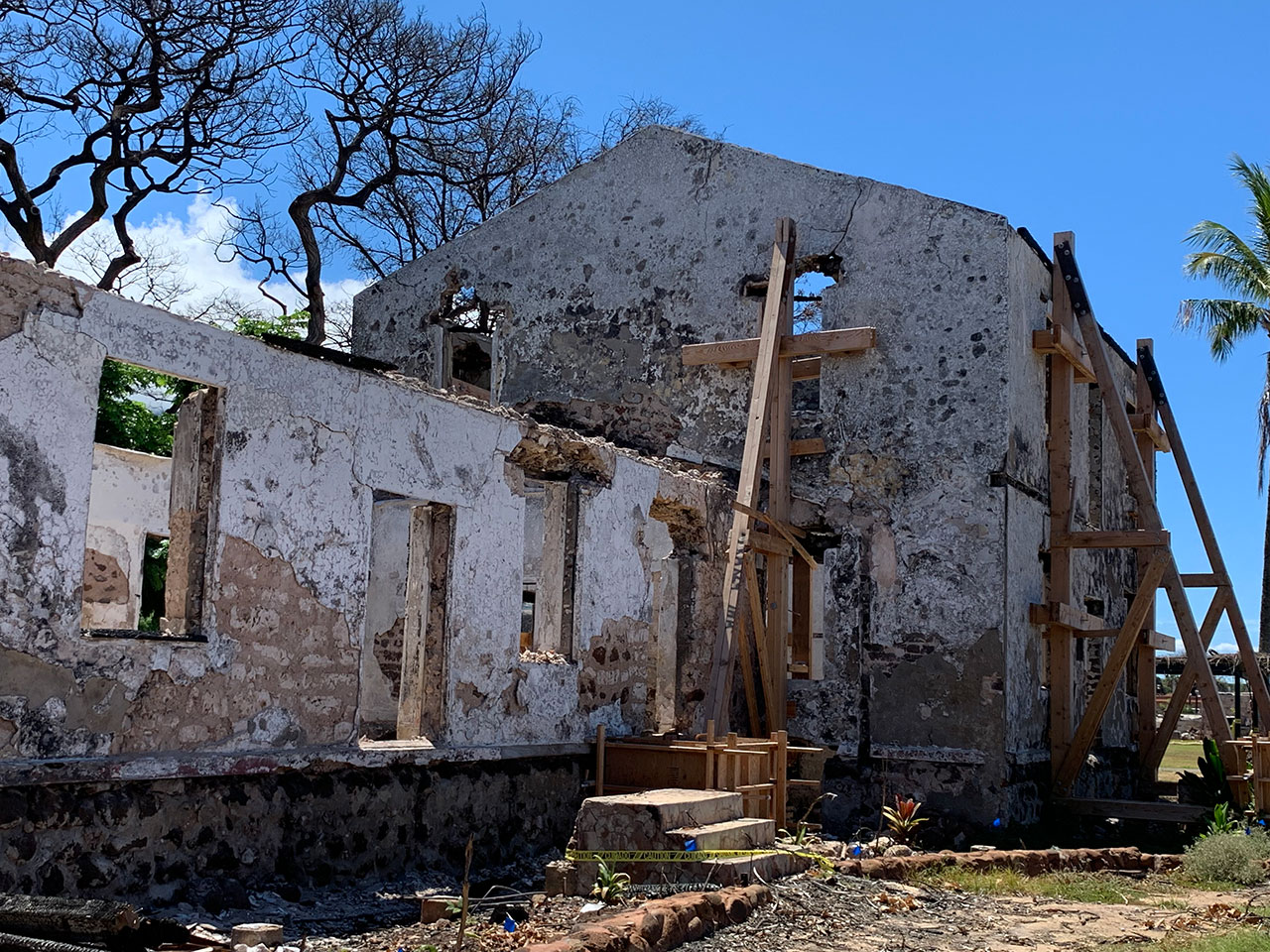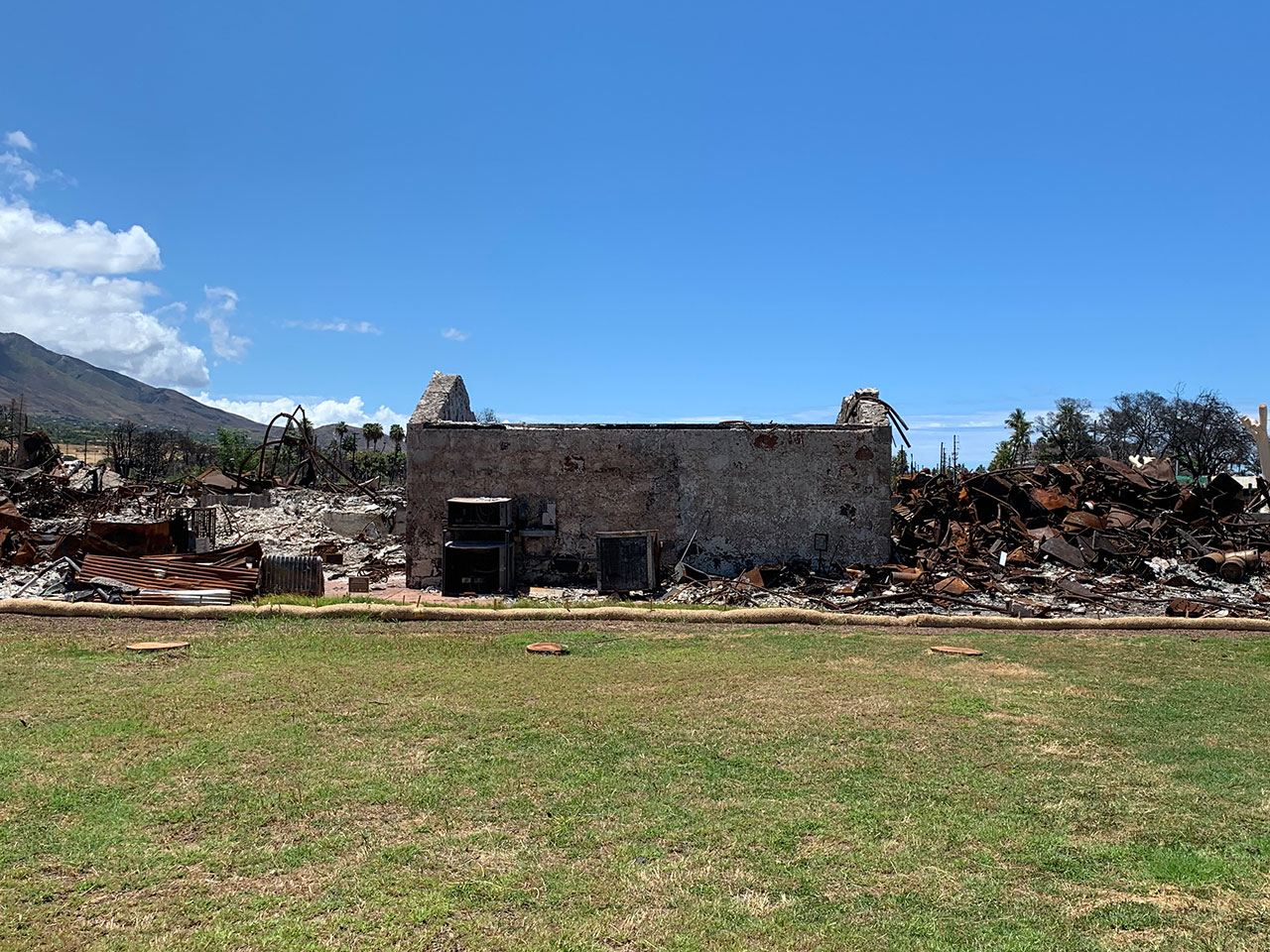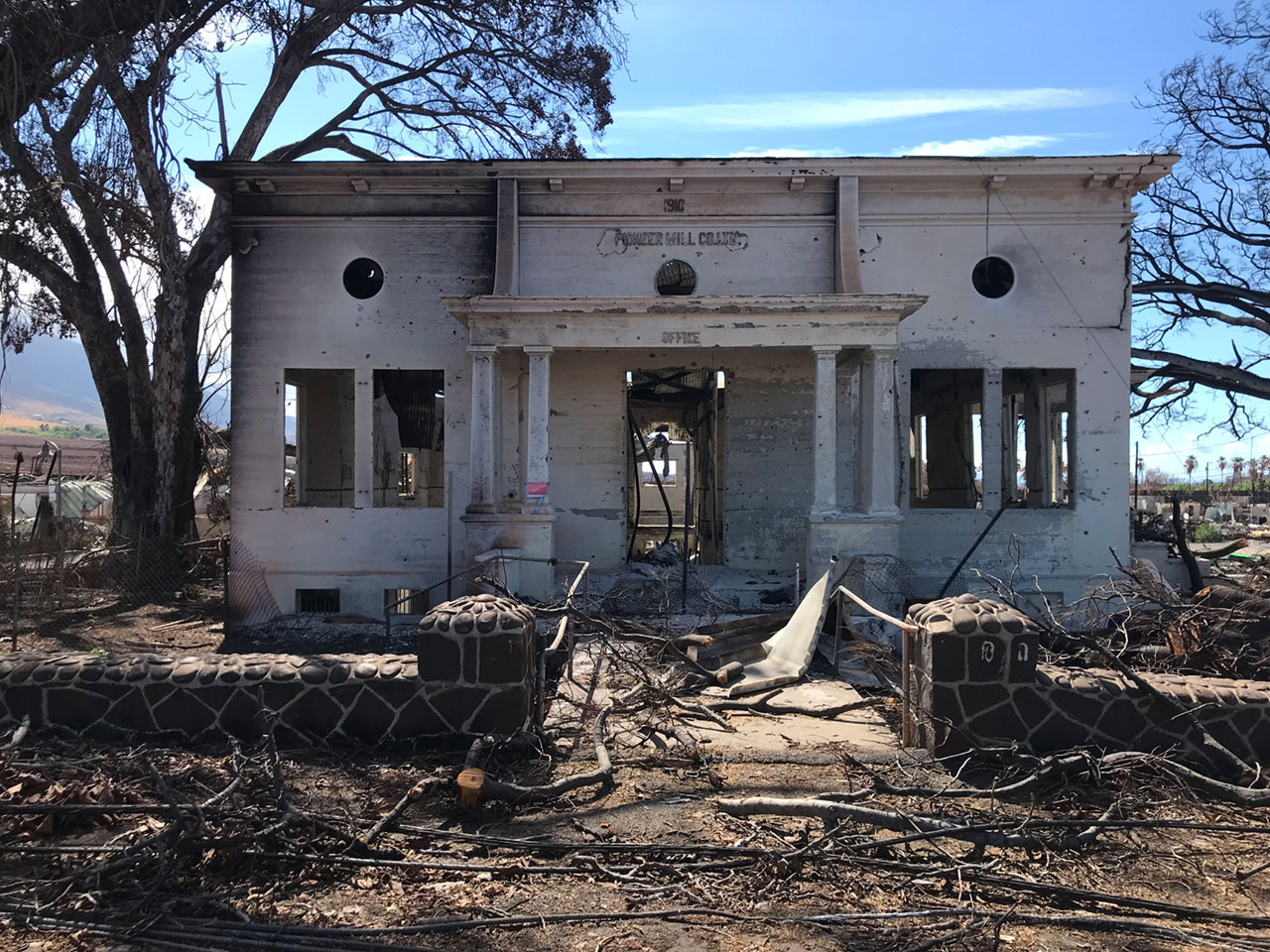
Baldwin Home, June 2024
10/24/2024: After the devastating fires on Maui last year, the impacts to historic buildings and sites are still being evaluated, with intentions to stabilize and restore as many as possible.
Of the ten historic structures listed as contributing to the Lahaina National Historic Landmark (NHL) District, two were destroyed outright by the wildfires that devastated Lahaina in August 2023, while portions of seven remain, mostly due to their stone construction.
- Pioneer Inn burned completely while Waiola Church is too damaged to preserve.
- Maria Lanakila Catholic Church escaped with only minor burns, as did the Waiola Cemetery.
- Baldwin House, Masters’ Reading Room, Hale Aloha, Old Lahaina Prison, Old Lahaina Courthouse, Seamen’s Hospital and Old Spring House were all heavily damaged but retained sufficient integrity to allow for future restoration.
In September, the U.S. Army Corps of Engineers (USACE) announced that debris from the wildfires had been removed from all Lahaina residential properties, covering some 1,390 lots. The debris removal effort had moved on to the commercial areas, with 102 of the 159 commercial lots cleared.
The final area to be cleared includes the Lahaina Historic District parcels. USACE identified five historic structures that would receive shoring and bracing efforts and would be protected during the debris removal activities. These include:
- Goo Lip Furtado Building, 693 Front Street
- Hale Aloha Church, 636 Luakini Street
- Old Lahaina Courthouse, 648 Wharf Street
- Old Lahaina Prison, 187 Prison Street
- Seamen’s Hospital, 1024 Front Street
The USACE engineers continued to assess the Baldwin Memorial Home and Master’s Reading Room to determine whether and how supplemental bracing would be installed. Lahaina Restoration Foundation installed emergency measures in January to prevent catastrophic collapse while waiting for the overall shoring project to commence. In the nine months since the emergency bracing was installed, the walls have remained standing, but additional cracks and damage are apparent. The structural engineers are assessing how to remove stresses and provide support.

Spring House, June2024
Unfortunately, several historic properties that had retained standing walls after the fire have not been saved. USACE determined that the Pioneer Mill Co. Office walls were too unstable to shore and the site was dangerous to enter. The walls were knocked down as part of the debris removal in September. The Kawaguchi Fish Market, Bank of Maui Block and Ichiki Store were also deemed too unstable to brace and the debris removal effort would be dangerous to the crews. They were all included in the demolition plans as part of the Consolidated Debris Removal Program (CDRP).
Some property owners also declined the offer to provide stabilization and shoring to retain the structures, instead asking the Federal Emergency Management Agency (FEMA) to demolish the historic walls and remove them along with the other building materials.
These demolition sites include the Old Spring House, which is identified in the NHL nomination as a key contributing resource. This small stone building was built in 1823 by Rev. William Richards to enclose the town’s spring. The Spring House protected the well that provided fresh water to the Richards’ residence, the town, as well as for merchant and whaling ships that docked at Lahaina to replenish supplies. A hand pump here was visited by crews of sailors who “constantly rolled huge casks for water.” According the nomination, the Spring House was one of the few remaining physical links with the whaling era.
USACE Technical Center of Expertise for the Preservation of Historic Buildings and Structures conducted a post-disaster assessment of the Spring House and determined that the remaining structure retained sufficient structural integrity to be rehabilitated at a future date.
However, because the Spring House was owned and used for commercial purposes prior to the fire, FEMA financial assistance would not be available for the eventual restoration of the property, as those programs are limited to properties that were in “public use” by government or nonprofit organizations.
FEMA informed the owners that if they did not have the property cleared as part of the current debris removal effort, that option would not be available to them later. The owners decided to allow demolition given the timeline and program requirements to participate in the debris removal program and the lack of other assistance programs.

PMCO Building, Demolished
In reviewing the situation, HHF provided comments to FEMA in July and August. Executive Director Kiersten Faulkner wrote:
“FEMA should provide other options to allow both for debris removal for the non-historic portion of the property AND to preserve and protect the historic Spring House.
“Rather than impose a rigid requirement for participating in the CDRP, which pre-empts meaningful alternatives to preserve this property, FEMA needs to provide alternatives to immediate demolition. Alternatives could include such actions as:
- Partial debris removal at this time for the non-historic portion of the property and the non-historic debris surrounding the Spring House, while simultaneously avoiding demolition of the standing walls and historic features. This should be offered along with a time extension for FEMA/USACE to complete debris removal at a future date if preservation options prove infeasible. That is, the owner would not have to “take it or leave it” right now in order to qualify for assistance.
- If the CDRP program itself cannot be modified to provide flexibility, FEMA/USACE should provide funds to allow the property owner to secure alternative debris removal in the future, thus allowing additional time to avoid demolition and finding a preservation alternative.
- FEMA and other Federal, State and Local partners should help the property owner secure funds for stabilization in the short term and preservation/rehabilitation in the long-term. If the owner had assurances that future rehabilitation would be affordable and supported, preservation becomes more feasible and risk is reduced.
- Each of these alternatives would preserve the opportunity to rehabilitate the Spring House at a later date. FEMA should not allow demolition until those choices play out, and should provide options so the property owner is not forced into a premature and damaging choice.”
However, FEMA said that its programs do not allow for these options and the Spring House would be demolished along with the debris clearance for the parcel.

